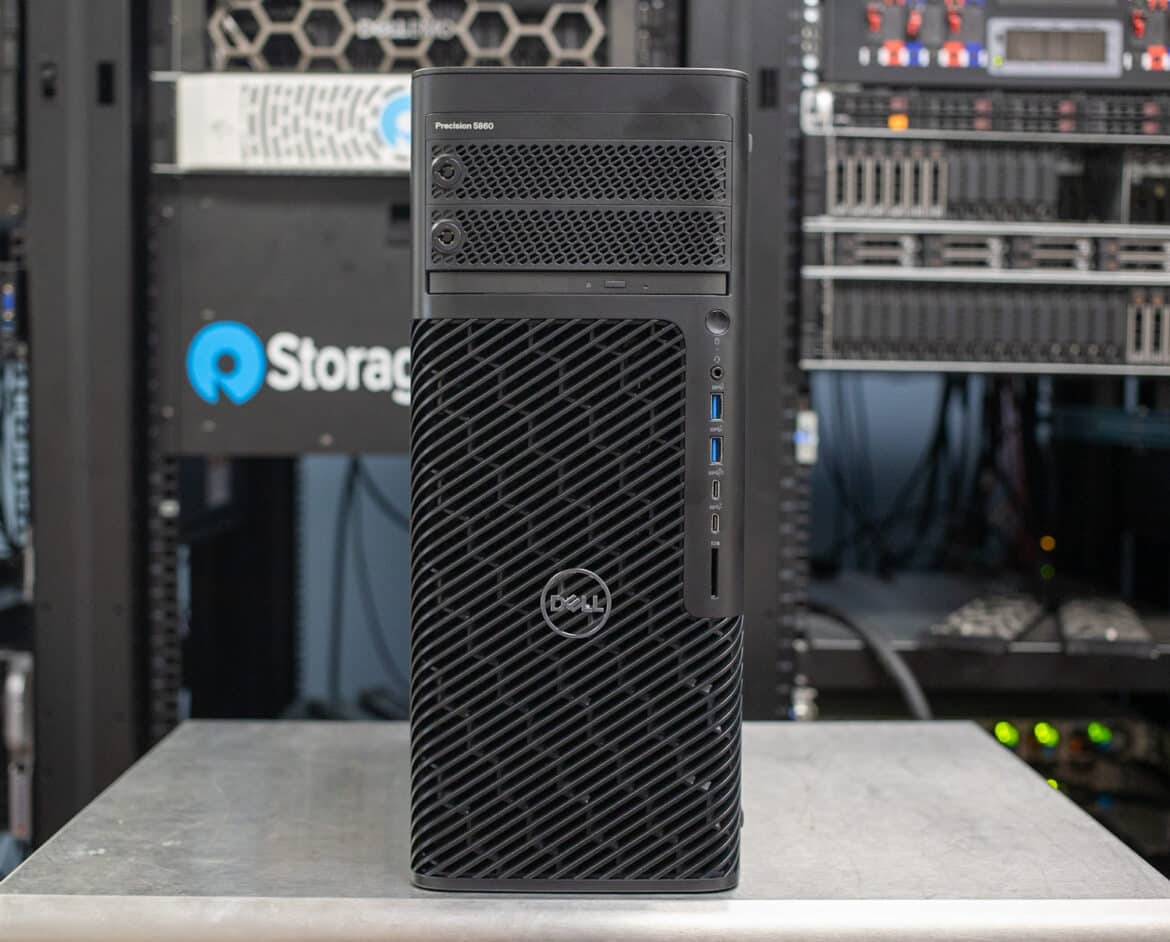The Dell Precision 5860 is a mid-tier Intel workstation, utilizing Intel Xeon W-class “Sapphire Rapids” processors with up to 24 cores, 2TB of RAM, and dual graphics cards.
The Dell Precision 5860 is a mid-tier Intel workstation, utilizing Intel Xeon W-class “Sapphire Rapids” processors with up to 24 cores, 2TB of RAM, and dual graphics cards.
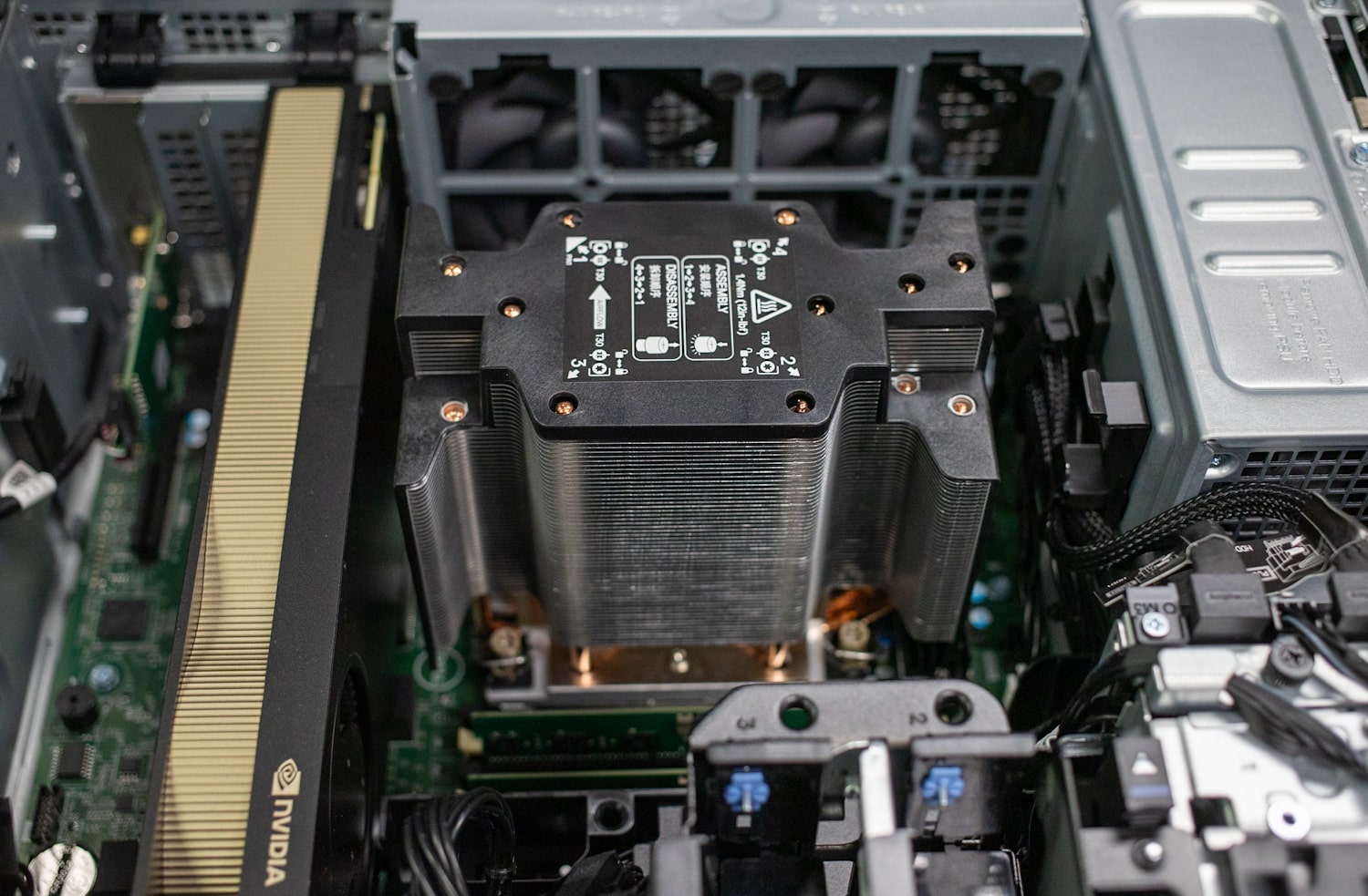
The Precision 5860’s CPU air cooler has 11 heatpipes.
Dell’s Precision fixed workstations come in many sizes, from the entry-level Precision 3260 Compact to the monolith Precision 7960. The Precision 5860 Tower reviewed here is the company’s most budget-friendly Intel workstation that uses true workstation-class processors. Its Intel Xeon W-class “Sapphire Rapids” chips offer many more cores, PCI Express lanes, and a higher memory ceiling than the consumer-grade Core class chips in the Precision 3660 Tower.
The Precision 5860 scales to the 24-core/48-thread Xeon w7-2495X; for more cores than that, you’ll need to step up to the Precision 7865 (AMD Threadripper Pro up to 64 cores) or the Precision 7960 (Xeon w9 up to 56 cores). It supports 2TB of DDR5-4800 ECC memory, PCI Express Gen5, two GPUs, a 1350-watt power supply, and countless storage drive configurations.
We aren’t testing the Precision 5860’s Intel vPro remote management feature, but Dell explains how it works. This tower also, of course, has a full suite of Independent Software Vendor (ISV) certifications, which guarantee that this tower will work properly with supported apps. (Dell maintains a list.)
The Precision 5860’s full specifications are as follows:
| Processor Options | Intel Xeon “Sapphire Rapids” w3 through w7, up to 24 cores |
| Operating System |
|
| Memory Options | Up to 2TB DDR5-4800 ECC (8 DIMM) |
| Storage Options |
|
| Graphics |
|
| Ports | Front:
Rear:
|
| Optical Drive | Optional slim DVD burner |
| Slots |
|
| Dimensions | US:
|
| Power Options |
|
| Chipset | Intel® PCH W790 |
| Hardware Security |
|
| Systems Management |
|
| Add-In Cards |
|
Dell Precision 5860 Build and Design
The Precision 5860 uses the same case design as the Precision 7865, measuring 16.29 x 6.79 x 16.9 inches (HWD). It weighs between 32 and 48 pounds depending on the configuration. Fortunately, Dell integrates a top carry handle in the event you need to move it.
The front grate is plastic; the side panels and internal structure are rolled steel. Dell says up to 61% of the plastic used in Precision fixed workstations is recycled. It offers EPEAT and Energy Star configurations and ships these workstations in 100% recycled or renewable materials that are 100% recyclable.
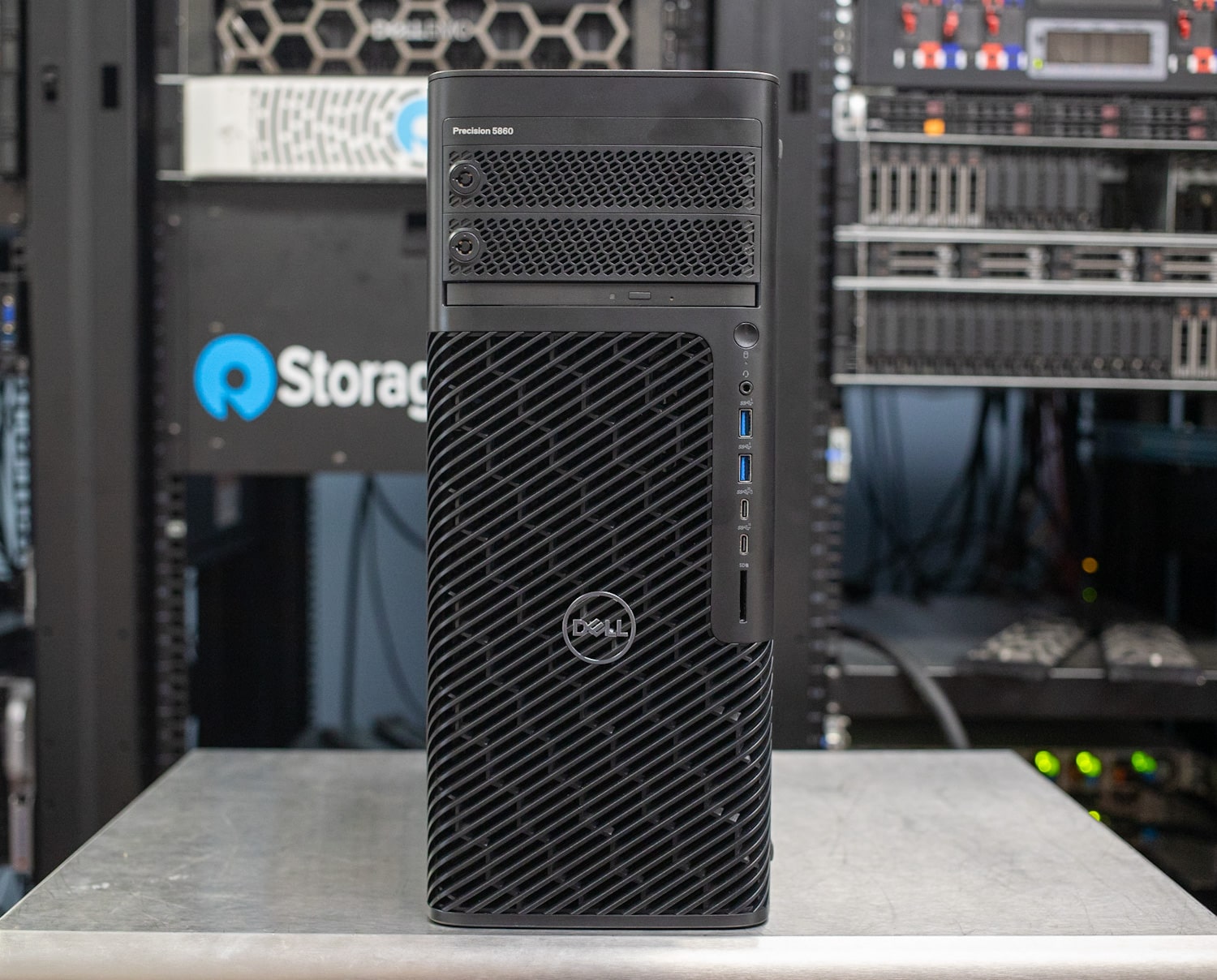
The Precision 5860 is a mid-tower workstation that can be oriented upright or on its side.
Front-panel connectivity includes two 5Gbps USB-A ports, two 10Gbps USB-C ports (one with PowerShare for charging devices when the tower is powered off), a full-size SD card reader, and a universal audio jack. Our unit also has the optional slim optical drive. The lockable flex bays just above that can hold external storage, either 3.5-inch SATA drives or NVMe M.2 drives. These are always important in a workstation to move data quickly from one machine to another.
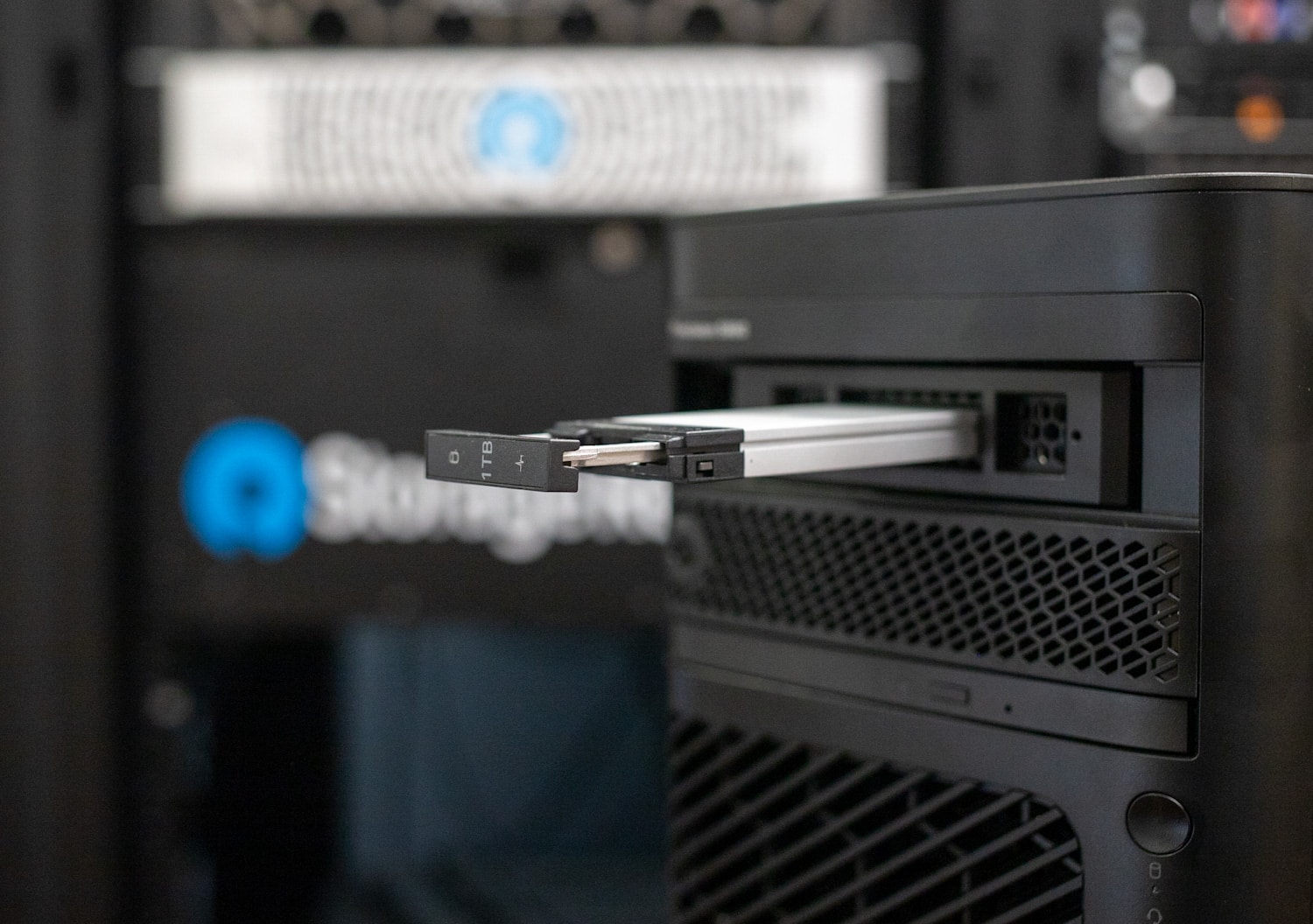
The front Flexbays support hot-swap M.2 NVMe drives.
Rubber feet on the left panel allow the Precision 5860 to be oriented horizontally as shown below. It can also be rack-mounted.
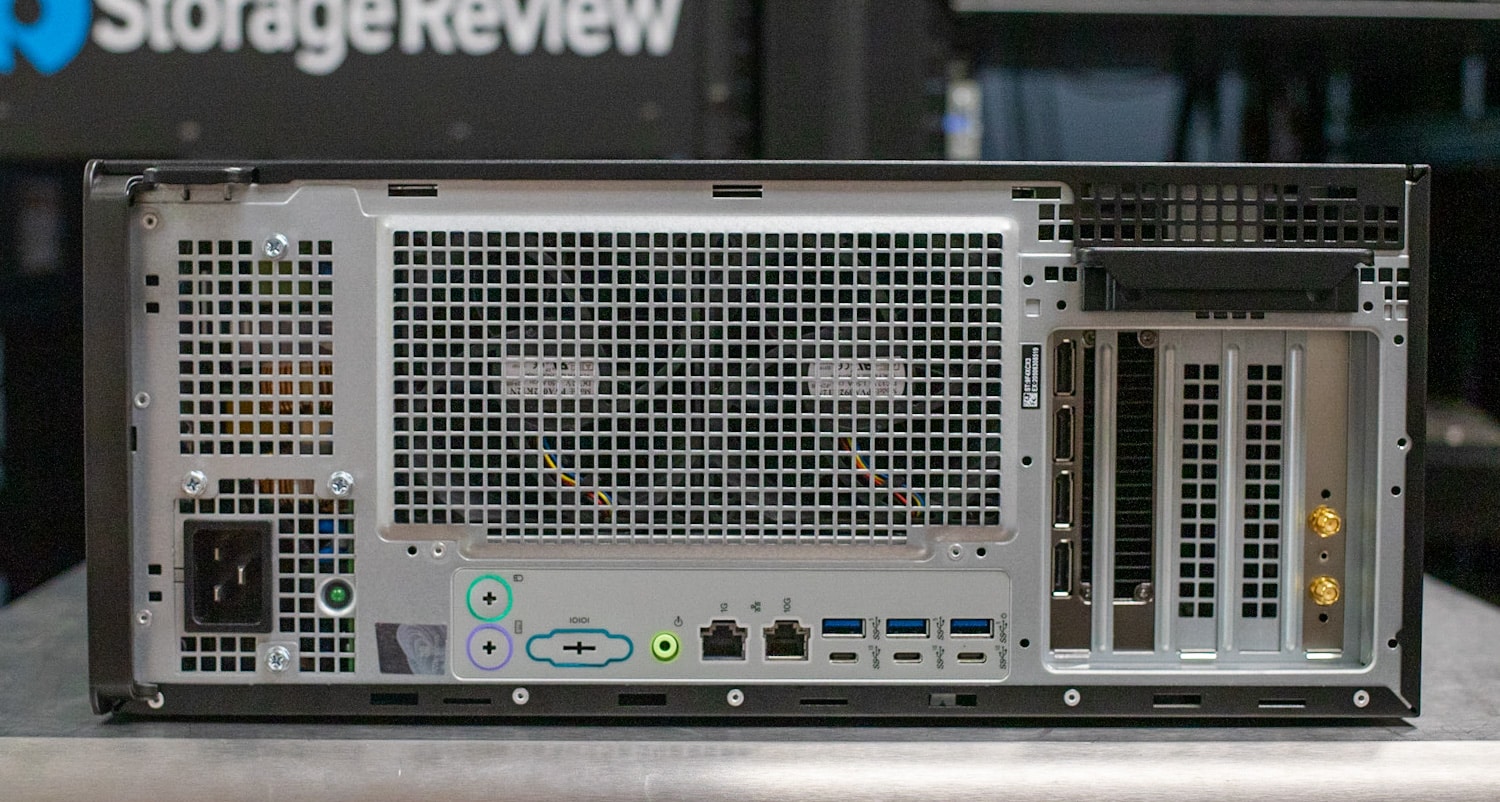
The Precision 5860’s rear has large airflow grates, expansion slots, and plenty of ports.
Huge airflow grates dominate the rear panel; the power supply is top-mounted. Dell offers 750- and 1,350-watt power supplies. Port selection includes 1GbE and 10GbE Ethernet, three 5Gbps USB-A, three 10Gbps USB-C, and audio line-out. Our unit doesn’t have the optional keyboard ports or the serial port. Naturally, you can add extra ports via the expansion slots. Our unit has a PCIe wireless card – stubby wireless antennas must be connected to its gold jacks for usable range.
The Precision’s side access panel has intrusion detection and can be configured with a security lock and a padlock. The large black plastic piece is the airflow guide for the processor and memory; it’s easy to remove by gripping the blue handles.
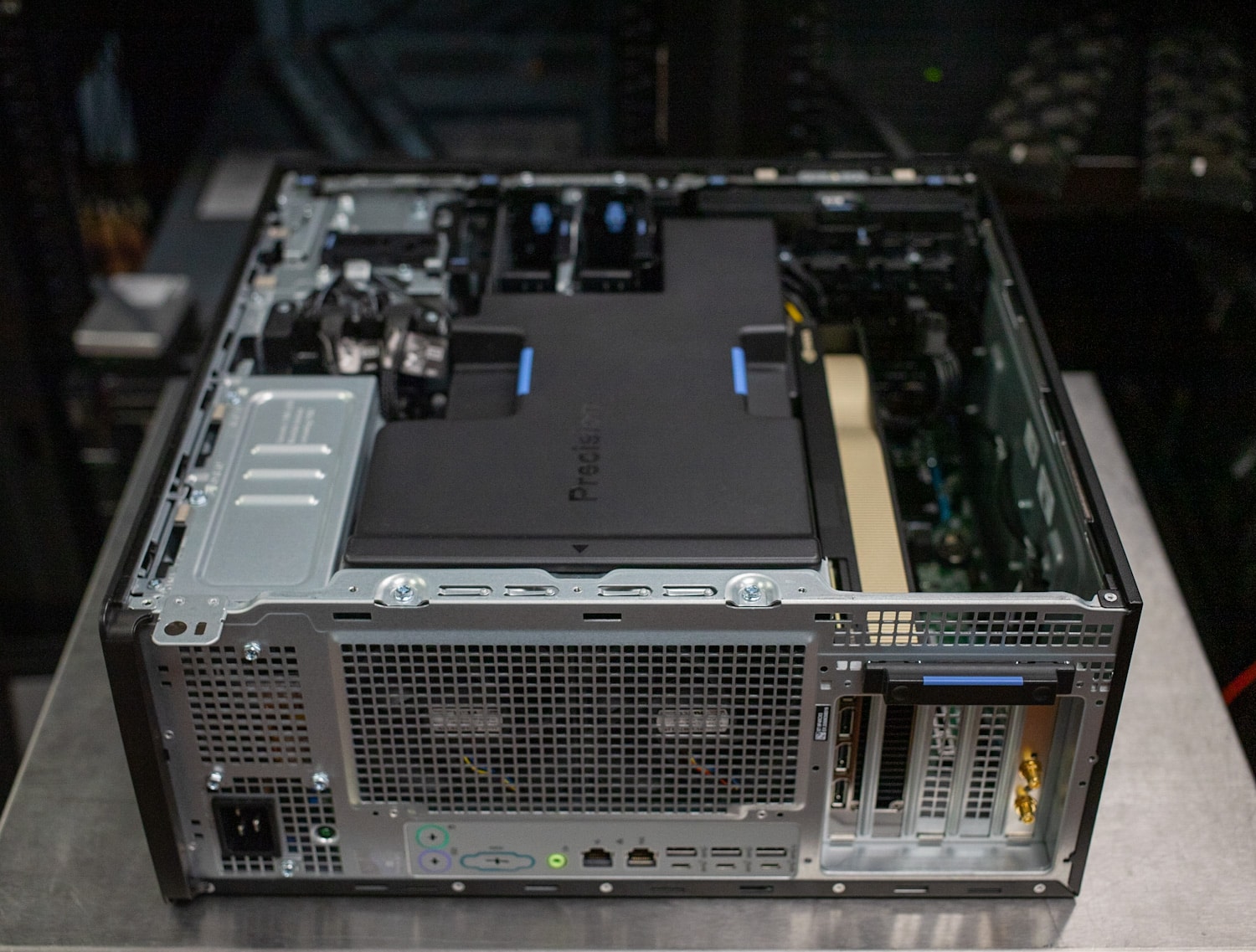
The Precision 5860’s interior has dedicated airflow guides.
The double-wide NVIDIA RTX A6000 is just below the airflow guide. The Precision 5860 accommodates two such GPUs. The following expansion slots are available:
- Full-height Gen5 PCIe x16 slot
- Full-height Gen4 PCIe x16 slot
- (2) Full-height Gen4 PCIe x8 slot open-ended
- Full-height Gen4 PCIe x8 slot (x4 electrical) open-ended
- (2) M.2 2230/2280 slots for PCIe NVMe Gen4 SSD
- (2) SATA slots for 2.5/3.5-inch HDD/SSD
Like most professional workstations, the Precision 5860 uses exclusively air cooling. The Xeon W-class processor is cooled by a massive tower heatsink with 11 heat pipes.
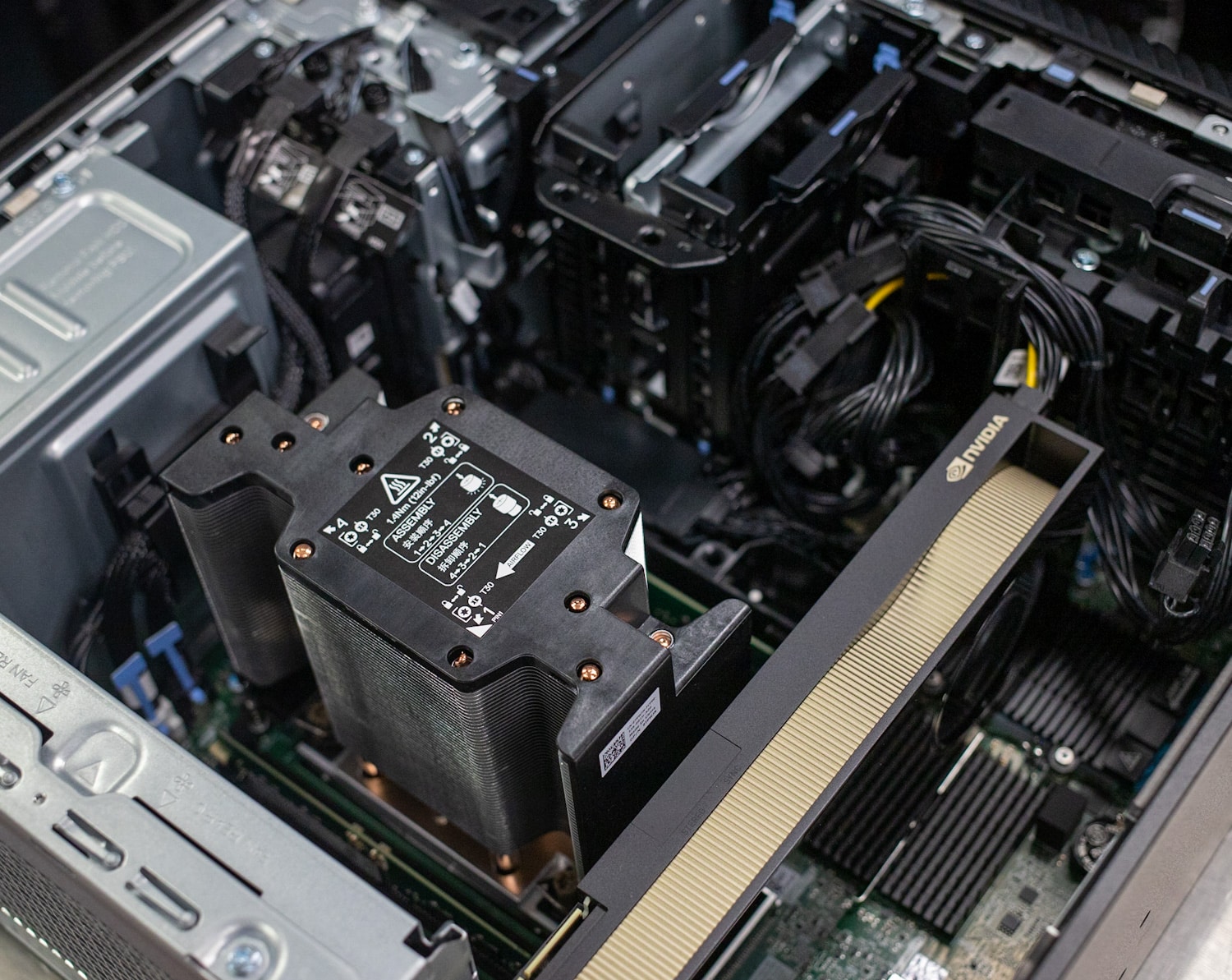
A large heatsink cools the Intel Xeon W-class processor.
Various heatsinks dot the Intel W790-based motherboard.
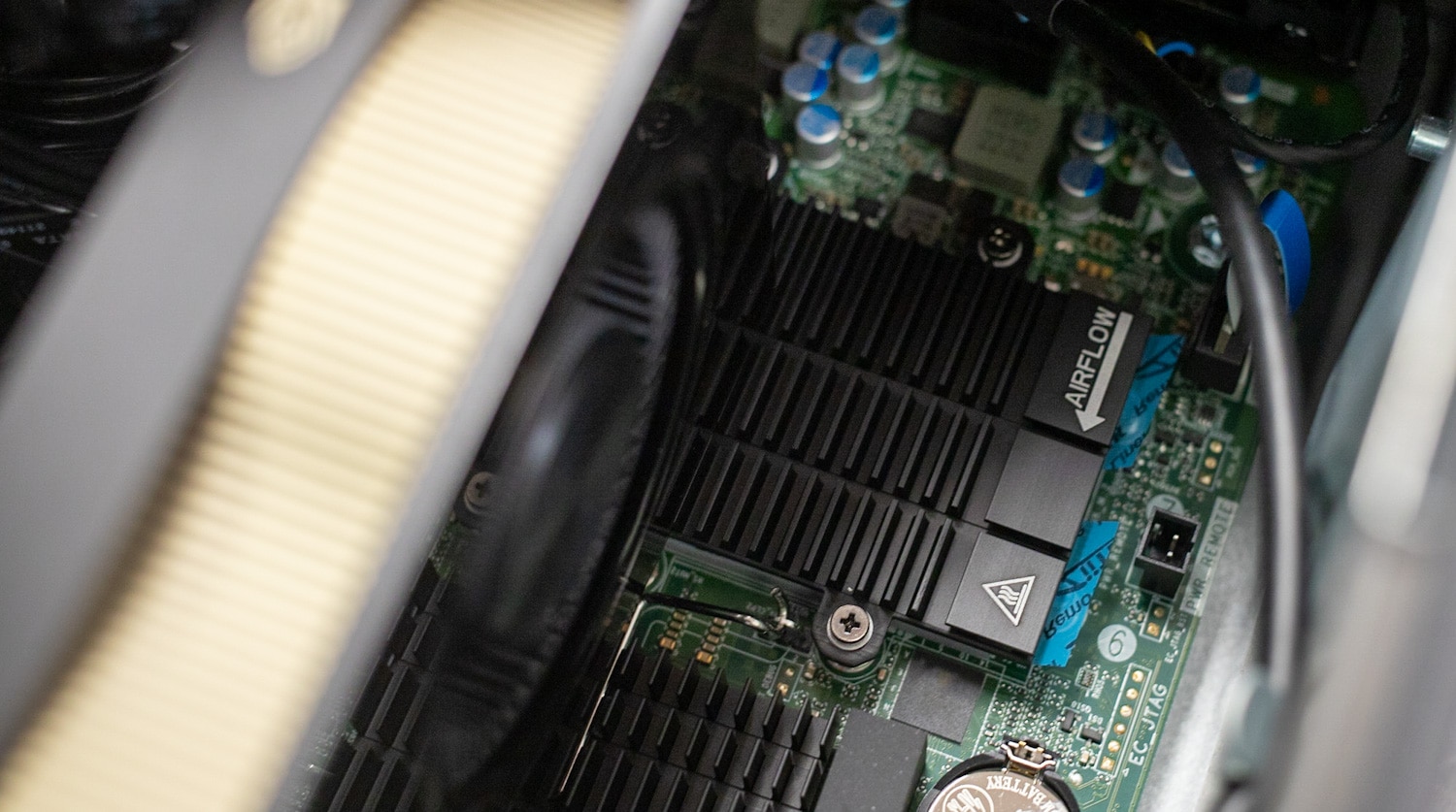
The Precision 5860’s motherboard has many heatsinks.
Overall, the Precision 5860 offers good serviceability and expansion.
Dell Precision 5860 Performance
We are testing the Dell Precision 5860 in the following configuration:
- Intel Xeon w7-2495X (24 Core/48 Thread CPU with 45MB Cache operating up to 4.8GHz)
- Windows 11 Pro for Workstations
- 64GB of DDR5-4800 ECC Memory (4x16GB)
- NVIDIA RTX A6000 with 48GB GDDR6 memory
- 2x 1TB Gen4 M.2 SSDs in RAID (Dell Class 40 drives)
- Qualcomm WCN6856-DBS. 2×2, 802.11ax + Bluetooth wireless card
- 8X DVD+/-RW slim optical drive
- 1,350-watt power supply
- Base price: $2,209
- Price as tested: $8,888.83
This is a high-end but well-balanced configuration for a mid-tier workstation. As noted, the Precision 5860 can be had with more memory (up to 2TB), many more storage drives, and another graphics card. This tower is highly expandable and could be upgraded down the line to remain relevant for many years.
The pricing is from Dell’s site, though it should be noted that Dell sells less than one percent of its Precision workstations through its site. The price you’ll be quoted as a commercial or enterprise customer may not match what we are publishing.
For performance comparison, we’ll be using the Precision 7865 configured 64-core AMD Threadripper Pro 5995WX, 64GB RAM, and an NVIDIA RTX A6000. The CPU benchmarks may be lopsided in the Precision 7865’s favor, but note that the tower can also be configured with 12-, 16-, or 24-core chips to be a viable alternative to the Precision 5860.
SPECviewperf 2020
Our first test is SPECviewperf 2020, the worldwide standard for measuring the graphics performance of professional applications under the OpenGL and Direct X application programming interfaces. The viewsets (or benchmarks) represent graphics content and behavior from actual applications, without having to install the applications themselves. The newest version of this benchmark went through major updates late last year, including new viewsets taken from traces of the latest versions of 3ds Max, Catia, Maya, and Solidworks applications. In addition, they added support within all viewsets for both 2K and 4K resolution displays.
The scores were about even between the two Precisions, an expected outcome since they use the same RTX A6000 GPU and CPU core count doesn’t really affect the outcome of this test.
| SPECviewperf2020 Viewsets (Higher is better) | Dell Precision 5860 (Xeon w7-2495X, RTX A6000) | Dell Precision 7865 (Threadripper Pro 5995WX, RTX A6000) |
| 3dsmax-07 | 140.87 | 140.79 |
| Catia-06 | 89.1 | 100.57 |
| Creo-03 | 125.11 | 137.39 |
| Energy-03 | 42.93 | 42.95 |
| Maya-06 | 327.89 | 334.18 |
| Medical-03 | 35.13 | 35.98 |
| Snx-04 | 480.1 | 453.83 |
| Sw-05 | 171.32 | 170.08 |
SPECworkstation 3
SPECworkstation3 specializes in benchmarks designed for testing all key aspects of workstation performance; it uses over 30 workloads to test CPU, graphics, I/O, and memory bandwidth. The workloads fall into broader categories such as Media and Entertainment, Financial Services, Product Development, Energy, Life Sciences, and General Operations. We are going to list the broad-category results for each, as opposed to the individual workloads. The results are an average of all the individual workloads in each category.
We only have results for the Precision 5860.
| SPECworkstation 3 (Higher is better) | Dell Precision 5860 (Xeon w7-2495X, RTX A6000) |
| M&E | 5.55 |
| ProdDev | 6.1 |
| LifeSci | 6.08 |
| FSI | 6.4 |
| Energy | 6.59 |
| GeneralOps | 2.97 |
| GPU Compute | 7.55 |
Blender OptiX
Blender is an open-source 3D modeling application. This benchmark was run using the Blender Benchmark utility. The score is samples per minute, with higher being better. The SuperMicro is excluded from this test since we only recently switched to a new version of Blender. The Precision 5860 slightly outdid its counterpart in the Junkshop and Classroom tests.
| Blender OptiX (Samples per minute, Higher is better) | Dell Precision 5860 (Xeon w7-2495X, RTX A6000) | Dell Precision 7865 (Threadripper Pro 5995WX, RTX A6000) |
| Monster | 2,804.91 | 2,839 |
| Junkshop | 1,777.03 | 1,595 |
| Classroom | 1,511.06 | 1,384 |
Luxmark
Another 3D benchmark we will be looking at is LuxMark, an OpenCL GPU benchmarking utility. Again we see little difference between the Precisions since this test is also GPU-oriented.
| Luxmark (Higher is better) | Dell Precision 5860 (Xeon w7-2495X, RTX A6000) | Dell Precision 7865 (Threadripper Pro 5995WX, RTX A6000) |
| Hallbench | 21,716 | 20,991 |
| food | 8,047 | 7,866 |
ESRI
Next up is the Environmental Systems Research Institute (Esri) benchmark. Esri is a supplier of Geographic Information System (GIS) software. Esri’s Performance Team designed their PerfTool add-in scripts to automatically launch the ArcGIS Pro. This application uses a “ZoomToBookmarks” function to browse various predefined bookmarks and create a log file with all the key data points required to predict the user experience. The script automatically loops the bookmarks three times to account for caching (memory and disk cache). In other words, this benchmark simulates heavy graphical use that one might see through Esri’s ArcGIS Pro software.
The tests consist of three main datasets. Two are 3-D city views of Philadelphia, PA, and Montreal, QC. These city views contain textured 3-D multipatch buildings draped on a terrain model and draped aerial images. The third dataset is a 2-D map view of the Portland, OR region. This data contains detailed information for roads, land use parcels, parks and schools, rivers, lakes, and hill shaded terrain.
First up is the Montreal model, where the Precision 5860 performs about the same as the Precision 7865.
| ESRI ArcGIS Pro 2.3 Montreal | |
| Average FPS | Average |
| Dell Precision 5860 (Xeon w7-2495X, RTX A6000) | 571.87 |
| Dell Precision 7865 (Threadripper Pro 5995WX, RTX A6000) | 574.46 |
| Minimum FPS | Average |
| Dell Precision 5860 (Xeon w7-2495X, RTX A6000) | 269.05 |
| Dell Precision 7865 (Threadripper Pro 5995WX, RTX A6000) | 272.18 |
The same was true in the next model, Philly.
| ESRI ArcGIS Pro 2.3 Philly | |
| Average FPS | Average |
| Dell Precision 5860 (Xeon w7-2495X, RTX A6000) | 455.11 |
| Dell Precision 7865 (Threadripper Pro 5995WX, RTX A6000) | 451.09 |
| Minimum FPS | Average |
| Dell Precision 5860 (Xeon w7-2495X, RTX A6000) | 267.14 |
| Dell Precision 7865 (Threadripper Pro 5995WX, RTX A6000) | 254.78 |
Last is the Portland model. This is the only model where the Precision 7865 showed significantly better performance than the Precision 5860.
| ESRI ArcGIS Pro 2.3 Portland | |
| Average FPS | Average |
| Dell Precision 5860 (Xeon w7-2495X, RTX A6000) | 1,105.49 |
| Dell Precision 7865 (Threadripper Pro 5995WX, RTX A6000) | 1,98656 |
| Minimum FPS | Average |
| Dell Precision 5860 (Xeon w7-2495X, RTX A6000) | 758.12 |
| Dell Precision 7865 (Threadripper Pro 5995WX, RTX A6000) | 1,280.95 |
OctaneBench
Next, we look OctaneBench, a benchmarking utility for OctaneRender, which is another 3D renderer with RTX support that is similar to V-Ray. Another GPU-limited test, the Precision 5860 and the Precision 7865 performed almost identically.
| OctaneBench (Score, higher is better) | Kernel | Dell Precision 5860 (Xeon w7-2495X, RTX A6000) | Dell Precision 7865 (Threadripper Pro 5995WX, RTX A6000) |
| Interior | Info channels | 18.15 | 18.39 |
| Interior | Direct lighting | 66.92 | 66.64 |
| Interior | Path tracing | 86.89 | 86.40 |
| Idea | Info channels | 11.35 | 11.33 |
| Idea | Direct lighting | 52.73 | 52.14 |
| Idea | Path tracing | 64.84 | 64.19 |
| ATV | Info channels | 28.53 | 28.75 |
| ATV | Direct lighting | 74.63 | 74.09 |
| ATV | Path tracing | 93.79 | 93.20 |
| Box | Info channels | 15.56 | 15.60 |
| Box | Direct lighting | 66.64 | 66.25 |
| Box | Path tracing | 75.42 | 75.01 |
Blackmagic RAW Speed Test
We have also started running Blackmagic’s RAW speed test, which tests video playback. This test doesn’t leverage every processor core and thread, so the Precision 7865’s 64-core AMD chip didn’t help it in the CPU test. The Precision 5860 scored higher in 8K CUDA, though that could have been attributable to GPU driver differences.
| Blackmagic RAW Speed Test (Higher is better) | Dell Precision 5860 (Xeon w7-2495X, RTX A6000) | Dell Precision 7865 (Threadripper Pro 5995WX, RTX A6000) |
| 8K CPU | 127 fps | 122 fps |
| 8K CUDA | 178 fps | 153 fps |
7-Zip Compression
The built-in memory benchmark in the popular 7-Zip utility shows marked difference between the Precision 5860 and the Precision 7865. Besides the obvious CPU core and thread count differences, the Precision 7865 has twice the memory channels (eight) which give it much greater bandwidth.
| 7-Zip Compression Benchmark (Higher is better) | Dell Precision 5860 (Xeon w7-2495X, RTX A6000) | Dell Precision 7865 (Threadripper Pro 5995WX, RTX A6000) |
| Current CPU Usage | 2505% | 3302% |
| Current Rating/Usage | 6.679 GIPS | 6.913 GIPS |
| Current Rating | 167.332 GIPS | 228.231 GIPS |
| Resulting CPU Usage | 2516% | 3293% |
| Resulting Rating/Usage | 6.676 GIPS | 6.973 GIPS |
| Resulting Rating | 167.962 GIPS | 229.630 GIPS |
| Decompressing | ||
| Current CPU Usage | 4725% | 6181% |
| Current Rating/Usage | 3.879 GIPS | 5.265 GIPS |
| Current Rating | 183.259 GIPS | 325.422 GIPS |
| Resulting CPU Usage | 4724% | 6188% |
| Resulting Rating/Usage | 3.874 GIPS | 5.265 GIPS |
| Resulting Rating | 183.014 GIPS | 325.813 GIPS |
| Total Rating | ||
| Total CPU Usage | 3260% | 4740% |
| Total Rating/Usage | 5.275 GIPS | 6.119 GIPS |
| Total Rating | 175.488 GIPS | 277.721 GIPS |
Blackmagic Disk Speed Test
We run the popular Blackmagic Disk Speed Test against the system’s primary storage drive. The Precision 5860’s RAID 0 M.2 Gen4 drives push the limits of the Gen4 interface.
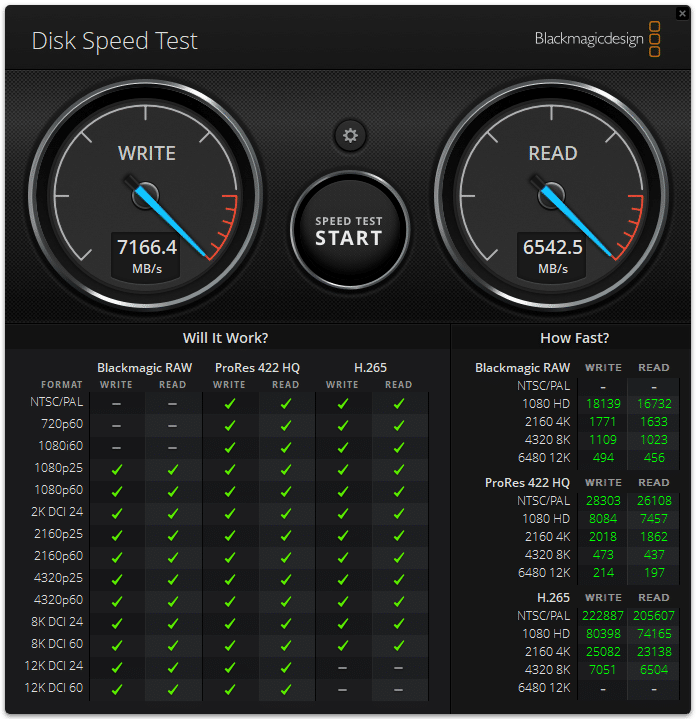
Geekbench 6
We also ran a few extra benchmarks on the Precision 5860, starting with the cross-platform Geekbench 6.
| Geekbench 6 (Higher is better) | Dell Precision 5860 (Xeon w7-2495X, RTX A6000) |
| CPU Benchmark (Single Core) | 2,302 |
| CPU Benchmark (Multi Core) | 17.320 |
| GPU Benchmark (Open CL) | 191,730 |
UL Procyon AI Inference
UL’s Procyon estimates a workstation’s performance for professional apps. We ran the test once on the CPU and once on the GPU. We only ran this test on the Precision 5860. Notice how much quicker the NVIDIA RTX A6000 handled this than the Intel Xeon CPU.
| UL Procyon Average Inference Times (Lower is better) | Intel Xeon w7-2495X | NVIDIA RTX A6000 |
| MobileNet V3 | 1.84 ms | 0.60 ms |
| ResNet 50 | 6.73 ms | 1.50 ms |
| Inception V4 | 18.58 ms | 4.62 ms |
| DeepLab V3 | 24.63 ms | 3.94 ms |
| YOLO V3 | 30.53 ms | 4.49 ms |
| Real-ESRGAN | 1,570.19 ms | 127.51 ms |
HWBOT x256 Benchmark
Another test we’ve started running is the HWBOT x265 benchmark. We ran the test on the Precision 5860 in 3x overkill mode and received an overall score of 41.57 fps in the 4k benchmark.
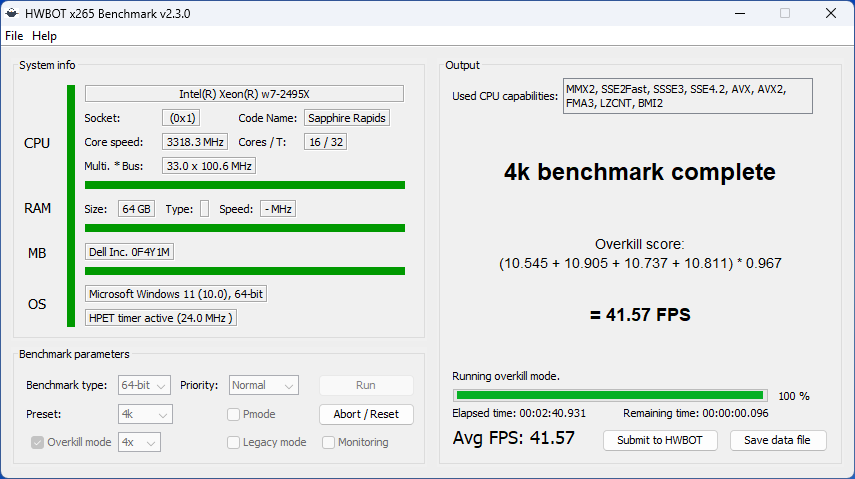
y-cruncher
y-cruncher is a multi-threaded and scalable program that can compute Pi and other mathematical constants to trillions of digits. Since its launch in 2009, it has become a popular benchmarking and stress-testing application for overclockers and hardware enthusiasts.
| y-cruncher (Total Computation time) | Dell Precision 5860 (Xeon w7-2495X, RTX A6000) |
| 1 billion digits | 16.009 seconds |
| 10 billion digits | 201.526 seconds |
Conclusion
True workstations offer expansion and security features above and beyond what would be found in an entry-level tower. The Dell Precision 5860 meets the definition in every sense of the word, thanks to its Intel W790 motherboard and Xeon W-class processor. This tower is configurable for extremely demanding tasks and 24/7 operation, with up to 24 cores, 2TB of RAM, and dual double-wide GPUs.
The Precision 5860 also rounds the bases in other expected areas for a workstation in this class, including ISV certifications, multiple mounting options, and externally accessible drive bays. The Precision 5860 gets our recommendation and is a strong option for a mid-tier enterprise workstation.
Engage with StorageReview
Newsletter | YouTube | Podcast iTunes/Spotify | Instagram | Twitter | TikTok | RSS Feed

